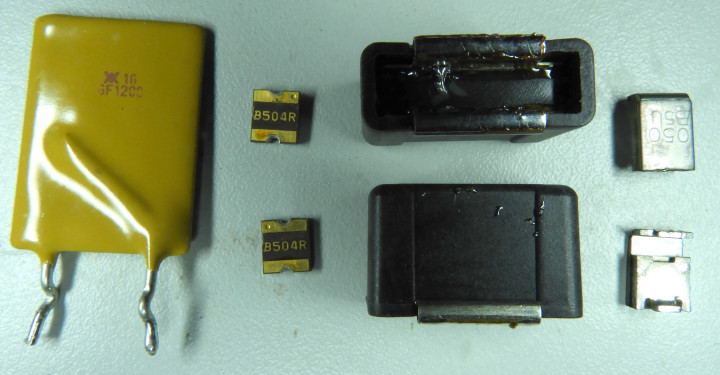The Polyfuse: Set-and-Forget Protection for Circuits
on

Do you have fuses everywhere, but not one to replace that which has just blown? Join the club! However, there is an alternative — the polyfuse. Discover how its clever chemical construction enables it to reset automatically.
Protect with a Polyfuse
How many times have you blown a fuse? The sacrificial fuse is a great component, preventing damage to the valuable circuit you’ve just built. But then, right after, you have the hassle of hunting down the correct replacement. And, if you’ve failed to fix the problem that blew the fuse in the first place, well, the new fuse blows too, compounding the hassle! Wouldn’t it be nice if we could have a self-resetting fuse? Well, there are circuit breakers. However, these are electromechanical devices that you have to reset yourself, and you can’t really get them in lower ratings than 1 A. Additionally, they are best suited to high voltage applications (well, high for us electronics types, anyway) like mains switchboards.
But there is a device that does what we want, capable of protecting low-voltage circuits with a current consumption down to around 100 mA or so. It’s called a polyfuse. Polyfuses are, in some ways, similar to Positive Temperature Coefficient (PTC) resistors in that they initially have low resistance. However, unlike PTCs, it is the self-heating effect caused by the flow of large currents that causes them to go high resistance, thus limiting the current to a safe value. They were discovered and patented by Gerald Pearson at Bell Laboratories in 1939 and are still widely used in professional electronic equipment.
These devices contain an organic polymer substance into which carbon particles have been impregnated. The polymer is usually in a crystalline state with its carbon particles in close contact providing good conduction at low currents. When a larger current flows, the carbon heats up, causing the polymer to expand into an amorphous state. This results in the carbon particles separating, leading to an increase in resistance and a subsequent reduction of the current. The residual current that flows under fault conditions will usually keep the device hot enough to limit the current until the cause of the overload is removed. At this point, it cools again, allowing current related to correct operation to flow again.
Polyfuses have a short but appreciable time delay in their operation. Because of this, they don’t protect against large surges and spikes. Their main benefit is their self-resetting nature, making them very useful for protection against short-term overloads and short-circuits in, for example, Power-over-Ethernet (PoE) circuits.

and various surfacemount components.
Set and Forget
Available in a wide variety of form factors, both as through-hole and SMD types as shown in Figure 1, they come in ratings from 100 mA up to about 5 A and are mostly intended for low voltage circuits up to about 30 V. Their specifications include a Hold Current, the current at which they will never trip, and a Trip Current, the minimum current at which they are guaranteed to trip. The trip current is usually about twice the hold current. Because they rely on temperature rise for their operation, their specifications change in higher ambient temperatures. After a trip condition, their resistance reduces to a lower value fairly quickly, but they may take a long time, sometimes days, to get back to their initial low resistance. This is something to keep in mind when designing with them.
As a cheap and compact component, polyfuses are great for set-and-forget protection in circuits that may be subject to occasional overload conditions.
Editor's note: This article appears in the September/October edition of Elektor.


Discussion (6 comments)